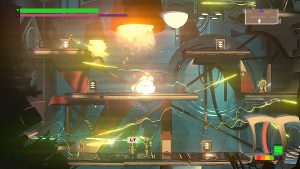Doublefine is a studio known for its quirky settings and gameplay to match. Sometimes we get interesting hits like Psychonauts and Stacked. Other times it can lead to a game being disjointed, such as Brutal Legend and Massive Chalice. The studio’s love of always going after something new also leaves their games somewhat unrefined. With that said, Headlander is the first game in a long time where I can say that we have a Doublefine title where everything clicks.
Heading to the Future:
The story of Headlander in typical Doublefine fashion is a bit kooky. It’s the far future (future as imagined from the 70’s), and humanity has replaced their human bodies with robots. Every robot in the universe is being controlled by an AI and everyone is pretty much crazy. You play the last human being left who must figure out a way to save humanity and defeat the AI…but there’s one other little detail.
It turns out that your body is also gone and you are literally a head in a flying space helmet. While you can’t speak, it does give the ability to hijack any robotic body to use for your own needs.
The gameplay of Headlander is metroidvania by way of puzzle solving instead of RPG. The robot bodies are color coded by rank; with higher colors doing more damage and having more health. Doors are color-coded throughout the game, and you can only open a door if you are the same or higher rank of that color.
Most offensive bodies have lasers that can also activate doors from afar and bounce around. If your body gets destroyed, you can pull the head off of another robot using your helmet’s vacuum ability. The only time you die is if your helmet runs out of health, but death simply restarts the room.
As with any Doublefine game, expect crazy visuals, unique characters and a story that will leave you guessing until the end. While Headlander is another wacky game from the studio, it’s surprisingly their most refined game to date.
A Good Head on Your Shoulders:
As I said further up, Doublefine is a studio known for experimenting. This can lead to unique, but unrefined gameplay. Headlander for the first time I can think from the studio remains consistently solid throughout the experience. The puzzle solving and combat mechanics mesh well together with the fact that there is always a body nearby preventing the player from being stuck.
Besides figuring out how to get specific color bodies to doors, there are puzzles built around navigating lasers, hitting switches and one section that can only be described as “Extreme Chess.” The mechanics are flexible enough that expert players can come up with little tricks to bypass parts or make things easier for them.
An upgrade system allows you to unlock new improvements and give you new tactics over time. As with the Metroidvania genre, there are hidden goodies spread throughout the game; some you can get right away, others that you’ll need to return to grab. The crazy situation helps to motivate you to keep going and see what else the game has behind its sleeves.
Headlander is one of the most refined game ideas from Doublefine despite the unusual situation, and only leaves me with a few nitpicks.
Head Scratching:
Headlander is a compact experience and can be beaten in a few hours. If you’re looking for Doublefine’s penchant for very different gameplay, you’re not going to find that Headlander is pretty restrained on that front. It’s one of those push and pull examples of balancing building a solid game while still experimenting.
Beyond the initial concept, Headlander doesn’t really grow over the span of playing in terms of new mechanics and situations. With exception to the boss sections, the game is pretty tame in terms of experimenting with different uses for body swapping.
The game’s upgrade system could be considered the least refined part of the game in my opinion. The upgrades ranged from head-saving like the force field and enhanced suction, to random with the ability to set up sentries and slow down time. While some upgrades did impact playing and finding secrets, I would have liked all the upgrades to be better integrated into the level and game design.
Backtracking can be annoying, as you’ll need to either keep your higher color body or hunt around for one in the area for the respective doors.
A Big Head:
Headlander may not be a long game, but it’s a great treat of meshing Double Fine’s visuals and storytelling with a solid gameplay experience. While you won’t be scratching your head to make sense out of it, at least heads won’t need to roll for you to finish it.
If you enjoyed this post, please consider donating to the Game-Wisdom Patreon campaign. Your donations can help to keep the site going and allow me to produce more great content. Follow me on Twitter @GWBycer, and you can find daily video content on the Game-Wisdom YouTube channel.




